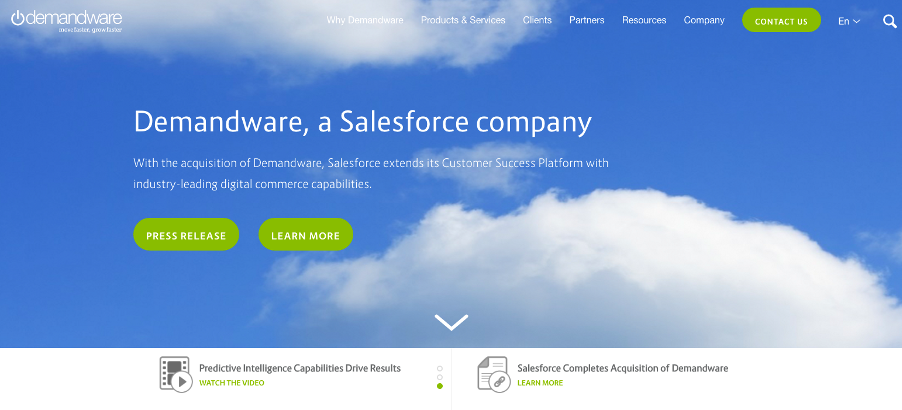02 Jun 4 Key SEO Considerations When Rebranding & Changing Domains via @TaylorDanRW
Rebranding happens for a number of reasons.
Whether it’s a result of a company acquisition or a business decision, changing company name (and oftentimes the domain name at the same time) introduces a number of risks to a website’s organic search performance.
During a rebrand and domain migration, there are a number of factors to consider, other than the more traditional SEO migration considerations.
In this article, I’m going to:
- Explore what some of these considerations, from experience, have been.
- Highlight examples of how some companies have handled this type of migration in the past.
Key SEO Considerations During a Rebrand & Domain Migration
1. If Possible, Generate Signals Beforehand
As with the examples further in the article who began to create signals prior to the migration, using the old website and domain as a vehicle to deliver signals of the transition over a short time period can ease the process for both users and Google.
Signals to increase the occurrence of the two websites/brands can be generated in a number of ways:
- Internally, through content and metadata changes.
- Externally, through traditional marketing and PR.
It’s also good practice to maintain elements of old branding on new metadata.
2. If Possible, Retain URL Structures
When performing any type of migration, changes to URL structures and content placement can lead to headaches and potential risks.
Keeping URL structures the same, or similar, and maintaining content levels can mitigate a number of these risks and help keep a number of signals consolidated.
This also makes redirects simpler, as they can be done through a single rewrite in the htaccess file:
RewriteEngine On RewriteCond %{HTTP_HOST} ^olddomain.com$ [OR] RewriteCond %{HTTP_HOST} ^www.olddomain.com$ RewriteRule (.*)$ http://www.newdomain.com/$1 [R=301,L]However, you also need to take into account the old domain’s history and links.
Google never forgets a crawl path.
Over time, the old URL will have picked up links that point to non-200 URLs, and gone through changes and potential restructures of its own.
As a result, you will still need to compile a thorough redirect list and process in order to retain all previous signals and equity.
3. Accommodate for Previous Brand Searches Through Content
If you’re moving from Brand X to Brand Y, people will still search for the previous brand name for years to come.
Case in point: Demandware.
According to Ahrefs, it still has a U.S. search volume of 2,800 despite being rebranded ~3 years ago to Salesforce Commerce Cloud (which by comparison has a U.S. search volume of 2,500).
This can be done through:
- Support sections.
- Blogs.
- FAQ pages.
Users (both new and existing) may have queries around the old platform still.
Leaving this traffic to the whims of third-party sites or competitors to satisfy their queries can be a missed opportunity.
4. Generate New Signals
One of the biggest mistakes I’ve come across when companies go through a rebrand and domain name change is that they look at traffic and ranking “KPIs”.
They don’t generate new signals for the new domain and brand through link building, digital PR, or traditional marketing.
Rather, they see organic as a channel in a silo.
When putting together the redirect lists, you will identify high importance links, potentially with branded anchors or commercial anchors pointing to the old domain.
These can still be outreach targets to try and have the link updated, but these efforts are not a substitute for fresh signals being put into the mix.
Examples of Rebranding & Domain Migration
As with a number of practices in SEO, best practice is often defined in theory with the practical application varying to accommodate other variables including business needs, resources, and platform/stack limitations.
Below are two examples of large companies who have gone through a name change as part of a rebrand or acquisition, and in the process needed to migrate the equity from one domain to another.
Demandware Becoming Salesforce Commerce Cloud

 Demandware’s homepage in May 2016 shortly after being acquired by Salesforce.
Demandware’s homepage in May 2016 shortly after being acquired by Salesforce.When Salesforce acquired Demandware, the transitioning of name and branding began in July 2016, with the homepage changing to the above.
They started to incorporate the Salesforce brand prominently across key Demandware landing pages.
Other prominent pieces of content and “signals” were also added to the homepage, such as the easy link through to the acquisition press release.
Over the coming months, the Demandware.com homepage (and brand) began its digital metamorphosis from the above image, to a completely Salesforce Commerce Cloud branded homepage in January 2017:

 The Demandware.com homepage in January 2017.
The Demandware.com homepage in January 2017.Eight months after the process started, with various stages listed below, there was no trace of the Demandware domain left on the homepage.
The domain now redirects completely to a product landing page catering for Demandware searchers on the core Salesforce domain.
Demandware Homepage Evolution Timeline
- June 2016: News articles about the acquisition started being linked to from the homepage.
- July 2016: Salesforce branding started to be introduced to the homepage.
- September 2016: A more robust visual change, with what turned out to be the template used in the January 2017 version, but still retaining Demandware brand visuals. Notably, at this stage Demandware was also being called “Demandware Commerce Cloud” across the site.
- October 2016: Header imagery reflected the shift that “Demandware is now the Salesforce Commerce Cloud.”
The January 2017 homepage used in the image above can be found here, and for comparison, the May 2016 homepage can be found here.
MaxCDN Becoming StackPath

 MaxPath’s homepage during the integration process to StackPath.
MaxPath’s homepage during the integration process to StackPath.For a long time, MaxCDN maintained the maxcdn.com domain before redirecting it to a tailored StackPath page where they clearly explained to users:
- Why they had been redirected.
- Why the page presented to them was covered in StackPath branding.
The Takeaway
Both the Salesforce and StackPath approaches can be seen as risky, as optimizing in this way could lead to brand cannibalization and affect your existing domains.
However, if managed over a short period of time and with other activities going on including traditional marketing and PR, the risks can be rewarded with creating early signals to combine the two entities and make the transition easier in the post-migration.
More Resources:
- How to Achieve an SEO-Friendly Website Rebrand
- Managing Successful SEO Migrations
- How to Handle SSL Certificates When Merging Domains?
Image Credits
All screenshots taken by author, May 2020
Sorry, the comment form is closed at this time.